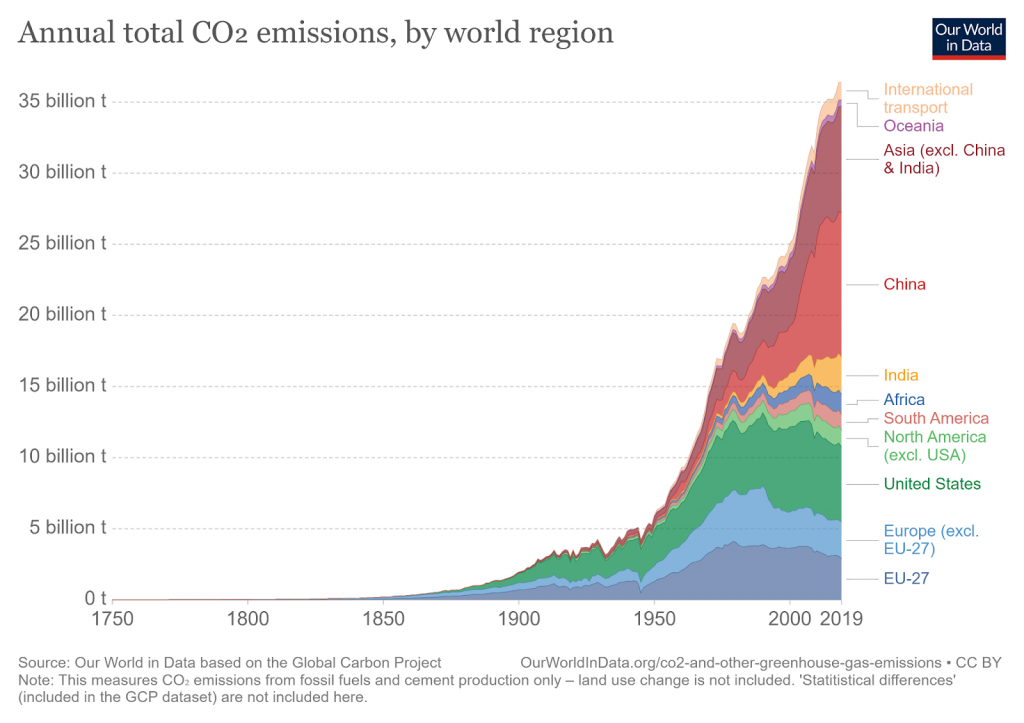Carbon Offsets vs Carbon Taxes: What’s the Difference?
Impactful Ninja is reader-supported. When you buy through links on our site, we may earn an affiliate commission.
Learn more
Learn more
.
Hey fellow impactful ninja ? You may have noticed that Impactful Ninja is all about providing helpful information to make a positive impact on the world and society. And that we love to link back to where we found all the information for each of our posts. Most of these links are informational-based for you to check out their primary sources with one click. But some of these links are so-called "affiliate links" to products that we recommend. First and foremost, because we believe that they add value to you. For example, when we wrote a post about the environmental impact of long showers, we came across an EPA recommendation to use WaterSense showerheads. So we linked to where you can find them. Or, for many of our posts, we also link to our favorite books on that topic so that you can get a much more holistic overview than one single blog post could provide. And when there is an affiliate program for these products, we sign up for it. For example, as Amazon Associates, we earn from qualifying purchases. First, and most importantly, we still only recommend products that we believe add value for you. When you buy something through one of our affiliate links, we may earn a small commission - but at no additional costs to you. And when you buy something through a link that is not an affiliate link, we won’t receive any commission but we’ll still be happy to have helped you. When we find products that we believe add value to you and the seller has an affiliate program, we sign up for it. When you buy something through one of our affiliate links, we may earn a small commission (at no extra costs to you). And at this point in time, all money is reinvested in sharing the most helpful content with you. This includes all operating costs for running this site and the content creation itself. You may have noticed by the way Impactful Ninja is operated that money is not the driving factor behind it. It is a passion project of mine and I love to share helpful information with you to make a positive impact on the world and society. However, it's a project in that I invest a lot of time and also quite some money. Eventually, my dream is to one day turn this passion project into my full-time job and provide even more helpful information. But that's still a long time to go. Stay impactful,Affiliate Disclosure
Why do we add these product links?
What do these affiliate links mean for you?
What do these affiliate links mean for us?
What does this mean for me personally?
![]()
Carbon offsets and carbon taxes are two methods to reduce global carbon emissions and mitigate climate change. To make informed decisions about global carbon reduction, we must identify the differences between the two. So we had to ask: What’s the difference between carbon offsets and carbon taxes?
Carbon offsets are investments in environmental projects that reduce carbon emissions elsewhere to compensate for your carbon footprint. Carbon taxes are a price tag put on fossil fuel emissions to disincentivize their use and promote a switch to green energy.
In the fight against climate change, how can we tell the difference between carbon offsets and carbon taxes? Below we will define both terms, identify the key advantages and differences of each, explore how they operate and what impact they have on carbon emissions, and discuss why they are important in the fight against climate change.
How Are Carbon Offsets and Carbon Taxes Defined
Carbon offsets and carbon taxes are two sustainability tools that can help individuals and organizations lower their carbon footprints. Each is used to accomplish specific, and very different, tasks but their overall goal is to reduce global carbon emissions.
What Does the Dictionary Say About Carbon Offsets and Carbon Taxes
Carbon offsets are a way to reduce carbon emissions beyond what we each can achieve through individual actions. They are measured in tons of carbon dioxide (CO2) equivalents and are bought and sold through international brokers, online retailers, and trading platforms.
“Carbon Offset: a way for a company or person to reduce the level of carbon dioxide for which they are responsible by paying money to a company that works to reduce the total amount produced in the world, for example by planting trees”
Oxford Dictionary
Carbon offsets play a crucial role in reducing our carbon footprint, the amount of CO2 emissions associated with an individual or an entity and one of the ways we measure the effects of human-induced global climate change. But offsets are not the only available tool. Carbon taxes, a form of carbon pricing, are another option to reduce CO2 emissions.
“Carbon Tax: a tax on the use of fuels that produce gasses that harm the atmosphere”
Cambridge Dictionary
Carbon emissions already have a price tag attached to them, but it is our environment who pays the price, not the emitters. A carbon tax is a fee placed directly on the burning of fossil fuels (i.e., coal, oil, and natural gas). And it is the only way to make users of fossil fuels pay for the social, economic, and environmental damage caused when carbon is released into the atmosphere. Placing the tax on the fuel itself creates a monetary disincentive that promotes the switch to greener energy by making it more economically rewarding to use non-fossil fuels.
Finland was the first country to implement a carbon tax back in 1990, and now there are 64 carbon pricing policies (carbon taxes and cap-and-trade policies) in operation worldwide. 35 of these are carbon tax programs. As of 2021, Sweden had the highest and Poland the lowest carbon tax at $137 and <$1 per metric ton of CO2 equivalent, respectively.
The United States and Australia are currently the only two developed countries without some form of carbon pricing.
What Are the Differences Between and Advantages of Carbon Offsets and Carbon Taxes
Both carbon offsets and carbon taxes represent ways in which we can mitigate carbon emissions and global warming. But they are also different methods of climate action with different environmental impacts, making it important to understand their differences.
The main difference between carbon offsets and carbon taxes is that carbon offset prices vary between organizations and projects, but the carbon price is predefined with a carbon tax. Carbon offsets are also bought and sold on the voluntary market, whereas carbon taxes are levied directly by governments.
The following are key advantages of carbon offsets:
- They address both direct and indirect carbon emissions
- They can be purchased from a variety of projects including direct CO2 capture, renewable energy, energy efficiency, and carbon sequestration
- Additionality is guaranteed
The following are key advantages of carbon taxes:
- They generate revenue for governments to develop green energy
- Different fossil fuels can be taxed at different rates
- They provide social, economic, and environmental benefits
How Do Carbon Offsets and Carbon Taxes Impact Your Carbon Footprint
Choosing either carbon offsets or carbon taxes is great if you are looking to lower your carbon footprint. Knowing their similarities and differences is important when making a decision of which to use.
| Carbon Offsets | Carbon Taxes | |
| How are carbon emissions reduced | Purchasing carbon offsets funds carbon emission reduction projects, which either prevent CO2 from entering the atmosphere or remove it once it’s already there. | A fee is placed on fossil fuels, which creates a monetary incentive to switch to greener forms of energy. |
| Impact on own carbon emissions | Carbon offsets do not directly reduce your carbon footprint. | Carbon taxes do not directly reduce your carbon footprint. |
| Impact on global carbon emissions | Carbon offsetting mitigates the problem, but it doesn’t work at the core issue of reducing overall CO2 emissions. | Carbon taxes work at the core issue of reducing overall CO2 emissions. |
| Environmental benefits | Carbon offsets improve air quality and protect ecosystems. | Carbon taxes facilitate the switch to greener energy sources and promote energy independence. |
| Overall effectiveness in reducing carbon emissions | Carbon offsetting is effective if projects are additional, permanent, meet certain key criteria and project standards, and do not engage in greenwashing. | Carbon taxes are effective if they are complemented by programs that ensure people are not made worse off from increases in fossil fuel costs. |
How Do Carbon Offsets and Carbon Taxes Reduce Carbon Emissions
The goal of both carbon offsets and carbon taxes is to reduce carbon emissions in order to mitigate climate change.
- Carbon offsets: Offsets can represent direct or indirect emission reductions. Purchasing carbon offsets funds carbon emission reduction projects which either prevent CO2 from entering the atmosphere or remove it once it’s already there.
- Carbon taxes: Taxes represent indirect emission reductions. A price is placed on emitting fossil fuels, which creates a monetary incentive to switch to greener forms of energy with less carbon emissions.
When you hear the words “carbon offset”, think about the term “compensation”. Offsets represent the reduction, avoidance, destruction or sequestration of the equivalent of a ton of carbon in one place to “offset” an emission taking place somewhere else. Carbon offsets are designed for situations where emissions are impossible to reduce because you can use the funds to reduce emissions in other areas.
When you hear the words “carbon tax”, think about the term “price tag”. Governments set prices that emitters must pay for each metric ton equivalent of carbon they emit. Carbon taxes force emitters to take steps to reduce their emissions in order to avoid paying this tax. The less carbon they emit, the less money they spend, and the less carbon gets released into our atmosphere.
What Impact Do Carbon Offsets and Carbon Taxes Have on our Own Carbon Emissions
One of the best ways we can aid in the fight against global climate change is to reduce our carbon footprint. And to do this we first have to reduce our own carbon emissions.
- Carbon offsets: Carbon offsets do not directly reduce your carbon footprint.
- Carbon taxes: Carbon taxes do not directly reduce your carbon footprint.
One of the main limitations of carbon offsetting is that carbon offsets do not directly reduce your own carbon emissions, it only makes others reduce their carbon footprint to compensate for your carbon footprint. Coupled with direct measures of emission reductions, such as reducing individual energy use and consumption, offsetting can be more effective.
Carbon taxes do not directly reduce your own carbon emissions. Putting a price tag on carbon emissions is an indirect method of emissions reduction because people can continue to emit as long as they pay the price.
Coupled with direct measures of emission reductions, such as reducing individual energy usage and consumption, carbon offsets and carbon taxes can become more effective.
What Impact Do Carbon Offsets and Carbon Taxes Have on Global Carbon Emissions
Every year we pump over 36 billion tons of CO2 into the atmosphere, fueling climate change. This causes temperature and sea-level rise, melting of sea ice, changing precipitation patterns, and ocean acidification. Carbon offsets and carbon taxes aim to reduce global emissions and mitigate these negative environmental effects.
- Carbon offsets: Carbon offsetting mitigates the problem, but it doesn’t work at the core issue of reducing overall CO2 emissions.
- Carbon taxes: Carbon taxes work at the core issue of reducing overall CO2 emissions.
Carbon offsets do not have a significant impact on global carbon emissions because in comparison to our 36 billion tons of CO2 emissions, carbon offsets for only ~1 billion tons of CO2 have been listed for sale on the voluntary market. Meaning that only about 0.8-1% of our annual CO2 emissions are offset.
Carbon taxes have a significant impact on global carbon emissions. Carbon taxes internalize external costs on the environment by adding them onto the price of fossil fuels. In this way, the producer and consumer pays for the full price of fossil fuels, including external costs to the environment. Higher prices disincentivizes the use of carbon-intensive goods, which leads to a reduction in total carbon emissions.
The COVID-19 pandemic triggered the largest decrease in energy-related carbon emissions since World War II, a decrease of 2 billion tons. However, emissions rebounded quickly at the end of 2020, with levels in December ending 60 million tons higher than those in December 2019. This indicates that the earth is still warming at an accelerated rate, and not enough is being done to implement clean energy practices.

What Are the Environmental Benefits of Carbon Offsets and Carbon Taxes
Using carbon offsets and carbon taxes can reduce our consumption of fossil fuels which, in turn, reduces our carbon footprint. But their benefits go beyond reducing your overall carbon emissions to balance off your personal carbon footprint. They also come with various environmental benefits.
- Carbon offsets: Carbon offsets improve air quality and protect ecosystems.
- Carbon taxes: Carbon taxes facilitate the switch to greener energy sources and promote energy independence.
Carbon offsets can reduce overall CO2 emissions, leading to improved public health and healthier ecosystems. Offsets can reduce the instances of asthma, respiratory allergies, airway diseases, and lung cancer caused by carbon emissions. And healthy ecosystems have been linked with cleaner air, water, and food.
Carbon taxes incentivize companies to switch to greener energy sources including solar, wind, hydro, and geothermal energy. They do not emit CO2, nitrogen oxides, sulfur dioxides, or mercury into the atmosphere, soil, or water. And these pollutants are known to contribute to the thinning of the ozone layer, global sea-level rise, and the melting of our world’s glaciers.
Switching from fossil fuels to green energy also promotes energy independence. Being able to produce your electricity without the aid of foreign countries is an important step in becoming more self-sufficient.
How Effective Are Carbon Offsets and Carbon Taxes in Reducing Carbon Emissions
Carbon offsets and carbon taxes can be effective at reducing carbon emissions if they are used correctly.
- Carbon offsets: Different offset projects have different effectiveness rates, and carbon offsetting is effective only if projects are realized, additional, permanent, meet certain key criteria and project standards, and do not engage in greenwashing.
- Carbon taxes: Placing a price directly on fossil fuels is effective at reducing global carbon emissions if there are contingencies in place to ensure increasing costs do no cause unnecessary hardships for people.
Direct CO2 removal is the most effective category of offsets followed by renewable energy, energy efficiency, and carbon sequestration. But most importantly, carbon offsets must be realized in order to be effective. When offsets do not get realized they do not offset any carbon, and we don’t reduce any emissions. A main problem with carbon offsets is that the number of sellers on the voluntary carbon market exceeds the buyers by about 600-700 million tons. Meaning that only about 300-400 million tons of CO2 offsets actually get realized.
Carbon taxes are effective at reducing carbon emissions because they force emitters to pay for fossil fuel emissions. The money generated from a carbon tax could then be used to offset energy costs for low income families, fund green energy technology, help combat climate change, or be given back to citizens as a dividend. But taxes can only be effective if they are complemented by programs that ensure people are not made worse off from increases in fossil fuel costs. Fossil fuels have been powering economies for over 150 years and currently supply approximately 80% of the world’s energy. Increasing the cost for fossil fuels could cause economic hardship for a large percentage of the world.
Why Are Both Carbon Offsets and Carbon Taxes Important to Fight Climate Change
Carbon offsets and carbon taxes are important to fight climate change because they are both ways to reduce your carbon footprint. Reducing your carbon footprint is important because it mitigates the effects of climate change, which has a positive cascade effect on public health and plant and animal diversity. In addition, this boosts the global economy and leads to innovative, more environmentally-friendly solutions.
However, carbon offsets and carbon taxes should not be used as a Panacea for climate change. Relying on offsets solely is impractical because there aren’t enough carbon sinks to offset every ton of CO2 produced from our collective human activities. And relying on carbon taxes still won’t be enough because people can still pay the price to emit carbon.
In the long term, direct methods of carbon footprint reduction are much more effective. Reducing your household, travel, and lifestyle carbon footprint can go a long way in the fight against climate change!
What are Better Alternatives to Carbon Offsetting and Carbon Taxes
If used correctly, carbon offsets and carbon taxes can provide environmental, economic, and social benefits that go beyond reducing carbon emissions. They have the potential to instigate meaningful environmental change and begin to reverse some of the effects of climate change.
However, we can’t let these two methods be a guilt-free way to reduce carbon emissions. Carbon offsets and carbon taxes must be used in conjunction with direct carbon reduction measures until the industry has time to invest, develop, and refine more sustainable innovations.
These reduction measures don’t have to involve drastic changes either. Actions that may seem small can have a big impact because those small changes add up! You can reduce your carbon footprint in three main areas of your life: household, travel, and lifestyle.
Reduce your household footprint:
- Wash with cold water: Washing clothes in cold water could reduce carbon emissions by up to 11 million tons. Approximately 90% of the energy is used to heat the water, so switching to cold saves also saves energy.
- Replace incandescent bulbs with fluorescent bulbs: Fluorescent bulbs use 75% less energy than incandescent ones, saving energy and thus reducing electricity demand and greenhouse gas emissions.
Reduce your travel footprint:
- Fly less: Aviation accounts for around 1.9% of global carbon emissions and 2.5% of CO2. Air crafts run on jet gasoline, which is converted to CO2 when burned.
- Walk or bike when possible: The most efficient ways of traveling are walking, bicycling, or taking the train. Using a bike instead of a car can reduce carbon emissions by 75%. These forms of transportation also provide lower levels of air pollution.
Reduce your lifestyle footprint:
- Switch to Renewable Energy Sources: The six most common types of renewable energy are solar, wind, hydro, tidal, geothermal, and biomass energy. They are a substitute for fossil fuels that can reduce the effects of global warming by limiting global carbon emissions and other pollutants.
- Recycle: Recycling uses less energy and deposits less waste in landfills. Less manufacturing and transportation energy costs means less carbon emissions generated. Less waste in landfills means less CH4 is generated.
- Switch from single-use to sustainable products: Reusing products avoids resource extraction, reduces energy use, reduces waste generation, and can prevent littering.
- Eat less meat and dairy: Meat and dairy account for 14.5% of global greenhouse gas emissions, with beef and lamb being the most carbon-intensive. Globally, we consume much more meat than is considered sustainable, and switching to a vegan or vegetarian diet could reduce emissions.
- Take shorter showers: Approximately 1.2 trillion gallons of water are used each year in the United States just for showering purposes, and showering takes up about 17% of residential water usage. The amount of water consumed and the energy cost of that consumption are directly related. The less water we use the less energy we use. And the less energy we use, the less of a negative impact we have on the environment.
Final Thoughts
In short, carbon offsets are not the same thing as carbon taxes. Carbon offsets represent the avoidance or removal of CO2 from the atmosphere via verified projects available for purchase on the voluntary market. Carbon taxes are fees placed directly on the burning of fossil fuels which creates a monetary disincentive for prolonged use and an incentive to switch to greener forms of energy. Taxes provide an economic signal to emitters rather than dictating where and how emissions should be reduced.
Both are tools in our sustainability toolbox that can be used to reduce carbon emissions and mitigate climate change. But we should not rely on either or both to be a cure-all for our environmental problems. Direct measures of carbon emission reduction are much more effective in reducing emissions both in the short term and the long term.
Stay impactful,

Sources
- United States Environmental Protection Agency: Offsets and RECs: What’s the Difference?
- David Suzuki Foundation: Are carbon offsets the answer to climate-altering flights?
- Impactful Ninja: Why Is a Carbon Footprint Bad for the Environment?
- Carbon Tax Center: What’s a carbon tax?
- Impactful Ninja: What Is the Carbon Footprint of Coal Energy? A Life-Cycle Assessment
- Impactful Ninja: What Is the Carbon Footprint of Oil Energy? A Life-Cycle Assessment
- Impactful Ninja: What Is the Carbon Footprint of Natural Gas? A Life-Cycle Assessment
- Union of Concerned Scientists: Carbon Pricing 101
- Citizens Climate Lobby: Carbon Pricing Around the World
- Statista: Carbon taxes worldwide as of April 2021, by select country
- Center for Climate and Energy Solutions: Carbon Tax Basics
- The World Bank: What is Carbon Pricing?
- GreenBiz: REC vs. Carbon Offset – Do You Know the Difference?
- Our World in Data: CO2 emissions
- National Wildlife Federation: Climate Change
- Yale Environment 360: Is the ‘Legacy’ Carbon Credit Market a Climate Plus or Just Hype?
- International Energy Agency: After steep drop in early 2020, global carbon dioxide emissions have rebounded strongly
- World Wildlife Fund: What is a Carbon Tax and How Could it Help us Fight the Climate Crisis
- Tax Foundation: Carbon Tax and Revenue Recycling: Revenue, Economic, and Distributional Implications
- Natural Resources Defense Council: Carbon Offsets 101
- National Institute of Environmental Health Sciences: Asthma, Respiratory Allergies and Airway Diseases
- National Institute of Environmental Health Sciences: Cancer
- Carbon Brief: Climate change will hit ‘endemic’ plants and animals the hardest, study warns
- U.S. Environmental Protection Agency: What is Green Power?
- White House Archives: Fact Sheet – Energy Independence and Security Act of 2007
- Carbon Offset Guide: Additionality
- Carbon Offset Guide: Permanence
- Terrapass: Carbon Offset Projects
- Edie: Carbon offsetting – How are businesses avoiding greenwashing on the road to net-zero?
- International Energy Agency: Direct Air Capture
- Smartgrid.gov: Renewable energy – The Smart Grid
- Carbon Offset Guide: Energy Efficiency
- Britannica: Carbon Sequestration
- Environmental and Energy Study Institute: Fossil Fuels
- ClientEarth: What is a carbon sink?
- The Ocean Foundation: Reduce Your Carbon Footprint
- Cold Water Saves: Washing Laundry In Cold Water Protects A Lot More Than Just Our Clothing.
- Energy Information Administration: Renewable Energy Explained
- Energy Star: Compact Fluorescent Light Bulbs (CFLs) and Mercury
- Our World in Data: Where in the world do people have the highest CO2 emissions from flying?
- Our World in Data: Which form of transport has the smallest carbon footprint?
- Zero Waste Europe: Reusable vs Single Use Packaging
- Carbonbrief: Interactive – What is the climate impact of eating meat and dairy?
- Stop Waste: Recycling and Climate Protection
- Impactful Ninja: Is Taking Long Showers Bad for the Environment?
- United States Environmental Protection Agency: Showerheads




